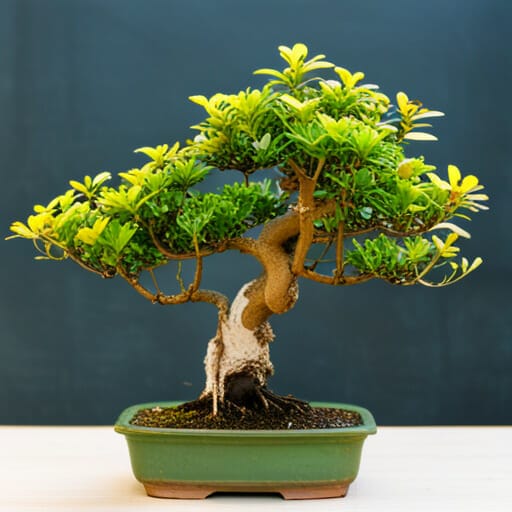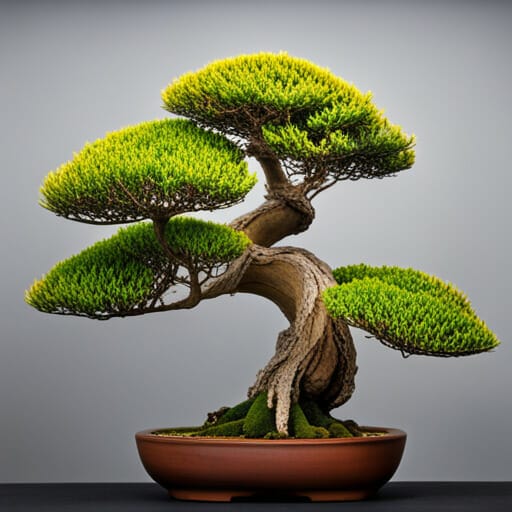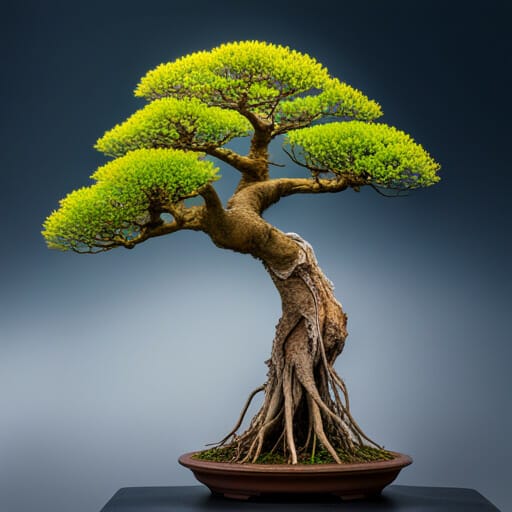In the world of bonsai, where miniature trees are meticulously crafted and nurtured, Lonicera Nitida stands out as an exceptional choice for enthusiasts seeking a tree with compact foliage.
This evergreen shrub, known for its aggressive growth and ability to respond well to pruning, offers a plethora of opportunities for shaping and creating dense foliage pads. The versatility of Lonicera Nitida allows for various styles, such as literati or deciduous, making it a tree that can cater to different artistic preferences.
Despite its fast growth, regular pruning can effectively manage the potential for long and leggy branches. Additionally, the tree’s thin bark, which peels off to reveal smooth bark underneath, presents an avenue for unique carving and the creation of deadwood features.
While it may pose challenges in thickening, Lonicera Nitida’s availability in nurseries and its responsiveness to work make it an excellent choice for bonsai enthusiasts aiming to cultivate a tree with thick and compact foliage.
Contents
- 1 Quick Points
- 2 Characteristics and Growth Habits
- 3 Pruning and Shaping Techniques
- 4 Root Development and Care
- 5 Frequently Asked Questions
- 5.1 How long does it take for Lonicera Nitida to develop a dense foliage pad?
- 5.2 Can Lonicera Nitida be trained into a cascade style bonsai?
- 5.3 Does Lonicera Nitida require special soil mix for optimal root development?
- 5.4 Is Lonicera Nitida susceptible to any specific pests or diseases?
- 5.5 Can Lonicera Nitida be grown as an indoor bonsai tree?
Quick Points
- Lonicera Nitida is a fast-growing evergreen shrub with small, compact leaves, making it ideal for bonsai.
- Lonicera Nitida responds well to pruning and can be shaped into dense foliage pads, allowing for quick ramification.
- Lonicera Nitida is easily found in nurseries and is a common garden shrub, making it readily available for bonsai enthusiasts.
– Lonicera Nitida’s aggressive root growth and ability to quickly fill a pot make it a suitable choice for bonsai.
Characteristics and Growth Habits

Lonicera Nitida exhibits characteristics and growth habits that make it an ideal bonsai tree.
This evergreen shrub is known for its small, compact leaves, which are desirable for creating a miniature tree effect.
Additionally, Lonicera Nitida is a fast-growing plant, allowing for quick development of bonsai features.
It responds well to pruning, making it easy to shape into dense foliage pads.
The ability of Lonicera Nitida to quickly ramify and develop dense foliage adds to its appeal as a bonsai tree.
While it may have long and leggy growth, regular pruning can manage this issue effectively.
Lonicera Nitida also back buds along its branches, enhancing its potential for bonsai styling.
Overall, the characteristics and growth habits of Lonicera Nitida make it an excellent choice for bonsai enthusiasts seeking a tree with compact foliage.
Pruning and Shaping Techniques

Pruning and shaping techniques for Lonicera nitida often involve frequent maintenance and careful attention to detail, resulting in a high success rate of achieving desired bonsai forms.
Pruning is necessary to maintain the compact foliage and desired shape of the tree. Regular pruning helps to control the growth and prevent the tree from becoming leggy. Lonicera nitida responds well to pruning and can be shaped into dense foliage. It is important to prune back to a bud or a leaf node to encourage new growth and maintain the tree’s desired form.
Shaping techniques such as wiring can also be used, but clip and grow is often preferred for creating dense foliage pads. With consistent pruning and shaping, Lonicera nitida can quickly build up thick and compact foliage, making it an ideal tree for bonsai enthusiasts.
Root Development and Care

Root development and care in Lonicera nitida involves consistent attention to ensure proper growth and health of the tree.
To promote strong and healthy roots, it is essential to provide the tree with well-draining soil to prevent waterlogged conditions.
Regular watering is crucial, ensuring that the soil remains evenly moist without becoming overly saturated.
Additionally, pruning the roots during repotting stimulates new root growth and prevents them from becoming pot-bound.
Fertilizing the tree with a balanced bonsai fertilizer helps provide essential nutrients for root development.
It is important to monitor the root system regularly for any signs of disease or rot, as prompt action can prevent further damage.
Proper care and attention to the root system of Lonicera nitida are vital for the overall vitality and long-term success of the bonsai tree.
Frequently Asked Questions
How long does it take for Lonicera Nitida to develop a dense foliage pad?
The time it takes for Lonicera Nitida to develop a dense foliage pad can vary depending on various factors such as growth conditions and pruning techniques. However, with frequent pruning and maintenance, Lonicera Nitida can quickly build up thick and compact foliage.
Can Lonicera Nitida be trained into a cascade style bonsai?
Lonicera nitida can be trained into a cascade style bonsai by gradually bending the trunk downwards and allowing the branches to cascade. This can create an elegant and dynamic appearance in the bonsai composition.
Does Lonicera Nitida require special soil mix for optimal root development?
Lonicera nitida does not require a special soil mix for optimal root development. However, it is recommended to use a well-draining soil mixture to prevent waterlogged conditions and promote healthy root growth.
Is Lonicera Nitida susceptible to any specific pests or diseases?
Lonicera Nitida is susceptible to certain pests and diseases. Common pests include aphids, scale insects, and spider mites, while diseases such as powdery mildew and leaf spot can affect its health. Proper care and regular monitoring can help prevent and manage these issues.
Can Lonicera Nitida be grown as an indoor bonsai tree?
Lonicera Nitida can be grown as an indoor bonsai tree. It is a suitable choice due to its small, compact foliage, which can be maintained through frequent pruning and maintenance.




